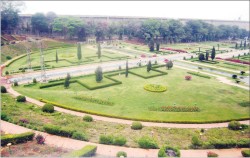
Mangalore :
The shortage of labour is a common problem among farmers.
Crops such as arecanut require skilled persons to climb the trees to pluck arecanut bunches from the plant.
What if any member of the farmer’s family can climb the tree? That is what MK Kiran (30), a farmer from Mallesara village in Thirthahalli taluk of Shimoga district, has devised.
Kiran demonstrated an arecanut tree-climbing implement at a plantation of farmer Anantharamakrishna at Peruvai village in Dakshina Kannada district recently.
Kiran told Business Line that the prototype of arecanut tree-climber has been developed under the guidance of DN Venkat of Coimbatore.
Venkat has devised a climber for climbing coconut trees, he said.
Two steel frames, rubber bushes and ropes are the main parts of the arecanut tree-climber.
The basic principle is just like climbing an arecanut tree manually.
First, the steel frames are latched on to the tree trunk – one at the waist level of the person climbing the tree and the other on the ground. The person climbing the tree will have to sit on the frame at the waist-level and will have to pull up the frame at the ground level using his/her feet. Once the process is over, the person has to stand on the lower frame and pull up the upper frame further. These processes will continue till the person reaches the top.
To a query on the chances of these frames slipping, he said the rubber bushes inside the frames tightly hold them to the tree. The two frames are connected by rope or belt.
He has been working on this project for the past four years.
Stating that he had to face failures many a times, Kiran said he did not give up in spite of that. He has around 2-3 tonnes of scrap materials from this project at his home in Thirthahalli, he said.
This farm implement weighs around 6.5-7 kg and cost is around ₹10,500.
Kiran said that he climbed the prototype first.
“When I found it is safe for me, my mother and wife tried it. When I got their feedback that even they can climb the tree with ease, I ventured out to promote this implement,” he said.
source: http://www.thehindubusinessline.com / Business Line / Home> Markets> Commodities / by A J Vinayak / Bangalore – April 10th, 2014





